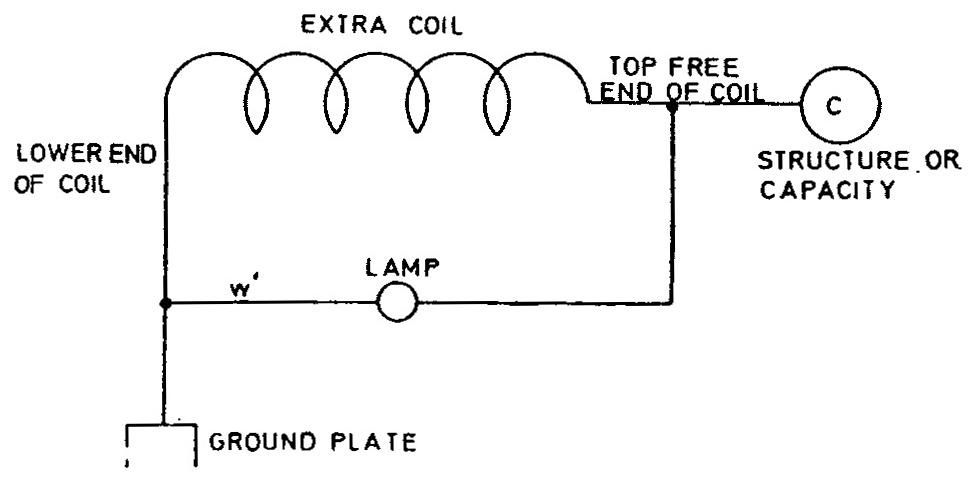
Nikola Tesla Books
turn with secondary short-circuited = 41,000 cm, as before, and all the turns of the regulating coil with connections, that is about 85,000 cm, giving total inductance at 41,000 + 85,000 = 126,000 cm or = $! {126 \over 10^{6}} $! henry. From this follows
$! {{2 \pi \over 10^{3}} \sqrt{0.0972 \times {126 \over 10^{6}}}} $! = $! {{2 \pi \over 10^{6}} \sqrt{12.2472}} $! = $! {{6.28 \times 3.5} \over 10^{6}} $! = $! {21.98 \over 10^{6}} $!
and
n = 45,496 or approx. 45,500 = n.
As will be seen from the consideration of the diagram above, in this experiment the entire energy supplied to the structure or capacity C had to pass through the lamp. Suppose the latter to consume 50 watts, and taking the capacity C with reference to previous estimates roughly at 500 cm. with the protecting hood, and designating with P again the potential to which the structure is charged, we have
50 = $! {{500 \over {9 \times 10^{11}}} \times {{p^{2} \times 45,500 \times 2} \over 2}} $! or P2 = $! {{9 \times 10^{8}} \over 455} $!
and
P = $! {{3 \times 10^{4}} \over \sqrt{455}} $! = $! {{3 \times 10^{4}} \over 21.3} $!
approx. or = 1409 volts = P, which is a very small pressure indeed. This pressure could have been, of course, still further reduced by using a resonating circuit of still higher frequency. In the manner just described and illustrated a great many lamps could have been lighted by the vibrations transmitted to the ground and some of the facts pointed out before will enable one to make an approximate estimate in this respect. However, by connecting the âextra coilâ as in normal operation, that is, to the free end of the secondary instead of to the ground, a number of lamps might have been lighted corresponding to the full output of the oscillator, say, one thousand lamps or more. Even through the ground, as in the experiment described, the action of the exciting circuit was so intense that the current of the supply transformers had to be cut down to but a very small fraction of the current taken by full output.
It should be remarked that also in the experiment described before (Plate XXVII.) a considerable number of lamps might have been lighted, but not nearly as many as in the case presently described, owing to the very small capacity of the lamps, as before stated.
The explanation to Photograph XXII concerning the transmission of power from the excited primary circuit to the âextra coilâ via the earth is similar to that he gave in 1893(6). The experiment to which the photograph refers was made with the aim of estimating the power of the oscillator from the thermal effect of the HF current. What Tesla calls the âtotal energy set in movementâ would correspond to the total energy transferred to condenser in the secondary (i.e. the power) if an energy of $!{1 \over 2}$! CV2 is transferred in each half-cycle. It can be shown that the active power dissipated in the circuit is much less than this and is inversely proportional to the Q-factor of the oscillating circuit.
January 2
Tesla gave his observations on 22 pages. On them he described eleven photographs. The explanation along with photograph No. 22 about energy transmission from excitation of the primary circuit to "additional coil" over the earth surface is similar to the one from 1893(6). Otherwise the experiment to which the photograph is related was performed for the purpose of oscillator power estimate on the basis of thermal effects of high frequency current.
That which Tesla calls "total energy placed in motion" would correspond to the total energy which is supplied to a capacitor per second (i.e. power) if energy ½CV2 is supplied during the duration of one half of the period.
It could be shown that the active power which is spent in the circuit is considerably smaller than this power, and opposite, proportionally to the quality factor of the oscillating circuit. On several following photographs, the movable resonant coil with connected bulbs is photographed which is supplied by transmitted high frequency energy. One terminal of this coil is connected to the ground, and the other is open ended or a short piece of wire is connected to it. Bulbs are coupled by means of the auxiliary secondary coil inductively with the secondary coil. The data was not given on the distance of resonant coil from the oscillator coil. Tesla's comment on photograph No. 27 illustrates the interest on the question of electrical lightning, though he worked on this for more than ten years. One earlier discovery on gas elimination and not only filament, when working with high frequency currents is again proven(5).
On photograph No. 28 the bulb is connected in series with a terminal capacitance load. In the calculations "total energy placed in movement" is not taken when it was assumed that the electrostatic energy ½CV2 is spent in the bulb during one half of the period. A similar comment is valid for photograph No. 29.
Tesla mentioned several times that the main transmission from the exciting to the excited circuit is done via the ground. The proof for this statement he found in the experiment illustrated by photograph No. 30. He concluded that the induced voltage in the excited circuit is significantly reduced when the ground connection is disconnected. Photograph No. 31 is an X-ray photograph of a finger. The comments on this experiment are an illustration of Tesla's interest in the radiation field which was mentioned earlier (please see comment on June 6, 1899).


